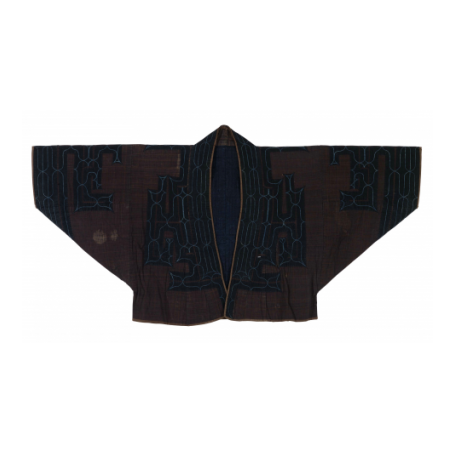RARE AINU CEREMONIAL DRESS *
Edo Period, circa 1850, 55x122cm
Starting from the end of the eighteenth century, in certain cases the elm fibre fabrics were replaced with pieces of cotton coming from Japanese manufacturers that, like all tissues Edo, had sober and often dark hues.
This antique and very rare Attus jacket from Meiji period, is the one of the typical wear of Ainu, aborigine lived in Hokkaido. Made of cotton, and added characteristic pattern, which are made with applique and embroidery. This piece has magic atmosphere, whose design has roots in ancient Jomon culture.

The word Ainu means "the People", and more precisely the People who came from Heaven. The Ainu are an ethnic group of probable Mongol-Siberian origin who, through the Shakhalin peninsula, arrived in Japan in prehistoric times. With physical characteristics (spreading high and a certain villosity in men) different from those of the "modern" Japanese, who are of Sino-Korean origin, their own religion (animist), language and culture(women, for example, used to tattoo their lips) the Ainu were a hunter-gatherers people, who came to inhabit the entire Japanese archipelago (the Fuji name, given to tis famous volcano, is a word ainu). We must therefore consider our own local aborigines and, for example, several points of contact with what we call 'Native Americans'. They also share their fate, it is true that in 1980 no more than 300 thoroughbred ainu horses were estimated - and about 15000 individuals with DNA contamination - all located in the northernmost part of the island of Hokkaido.
The contacts between Japanese and ainu begun soon, and it is in 658 the first documented battle between the two peoples occurred in the Tohoku region of the island of Honshu. Being the ainu society entirely based on its membership and on its prosperity, these existed as separate socio-political entities and therefore never formed a real nation. It follows that Japanese people had a good game in their progressive expansion towards north until when, between war and peacetime, all ainu found themselves confined to the island of Hokkaido, where they continued their hunting and fishing time interspersed with trades with the Manchurian Shakhalin tribes in the north, and the Japanese in the south. With the Meiji restoration (1868) the Japanese government encouraged the migration of settlers to the north, and slowly began the forced integration of the native, until it was said previously. Only very recently has it begun to look for this endangered culture.
Textile production was a female prerogative and, during the long winter months, wives and daughters produced garments for the whole family, using mostly fibres obtained from the bark of elm trees. The fabric thus obtained was used to make those garments (attush) adorned with decorations obtained by applying elaborate embroidery in leather or, in recent times, cotton. The decorations were originally exclusive references to the belonging clan. Since the fifteenth century, however, because of Japanese influence, this feature began to melt away to lose, with the attus of the nineteenth century, every specificity (if not a 'look' typically ainu). Nevertheless, even if relatively late, these objects provide an indication of ainu culture and have always been very sought after by the collector.
* no more in stock





